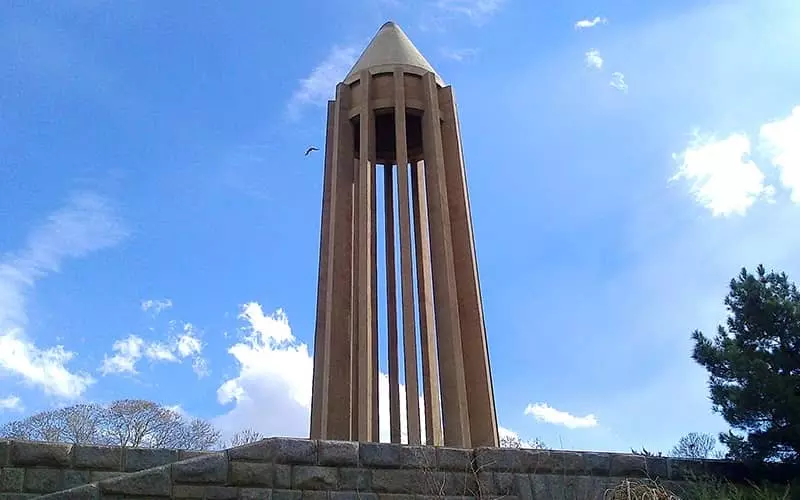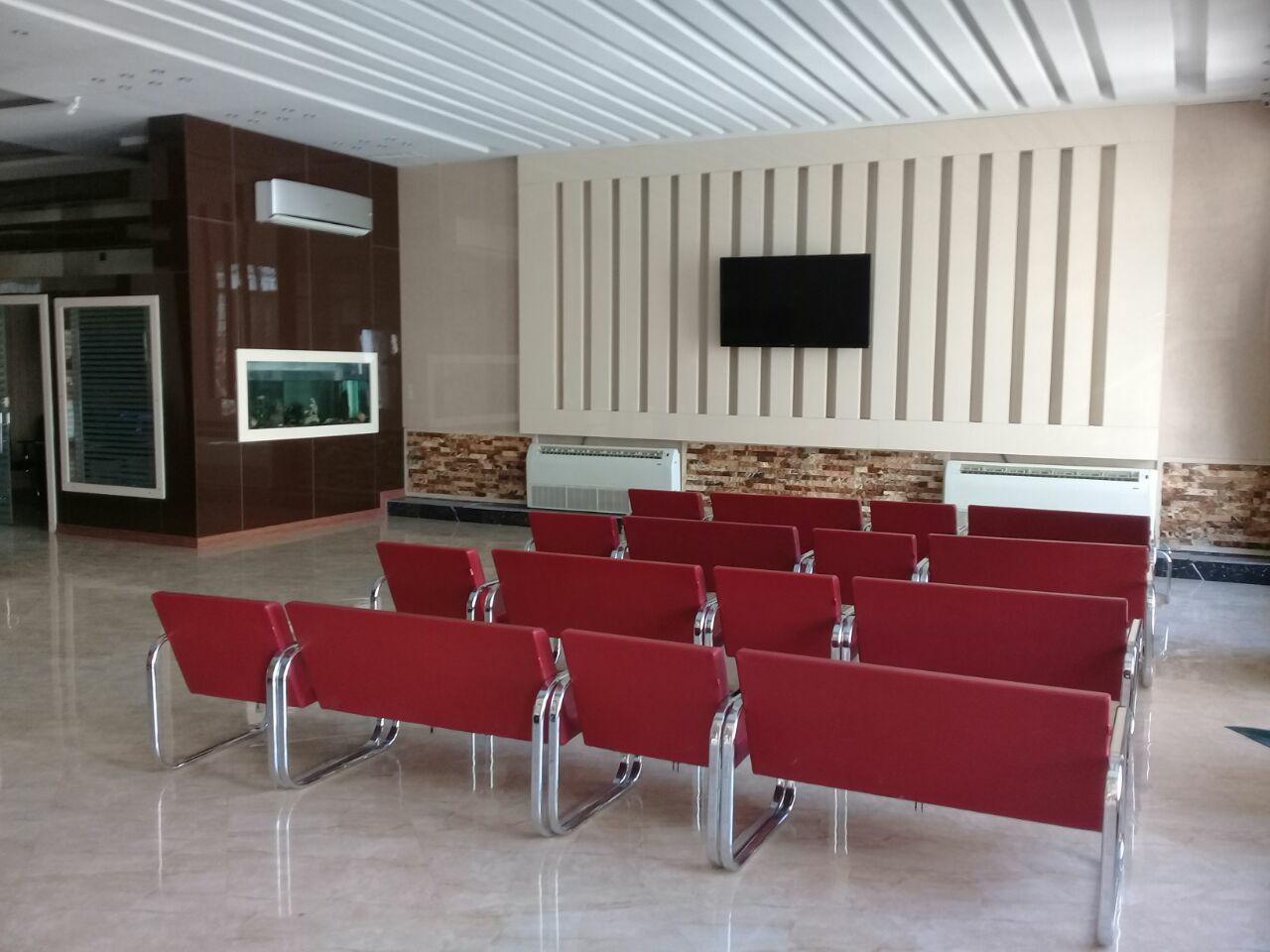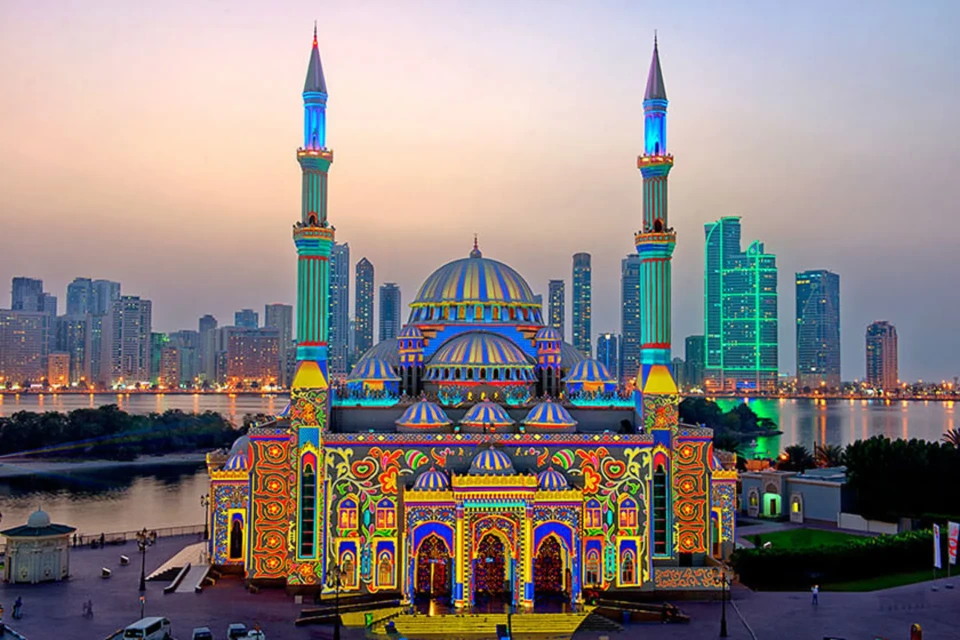Souvenirs of Kermanshah | Introduction to Various Foods and Handicrafts
Have you ever traveled to the beautiful city of Kermanshah, the westernmost city of Iran? If so, have you experienced the joy of wandering through its old bazaars and tasted the most famous souvenirs of Kermanshah? Kermanshah is the cradle of human civilization, and a trip there can feel like a journey into the world of historical events. This city is rich with historical, religious, and recreational attractions, not to mention its delicious local foods.
You might be surprised, but we consider Kermanshah’s souvenirs as one of the city’s major attractions, and just seeing them can be a delightful experience for tourists. Kermanshah’s souvenirs are not limited to edible delights either. The vibrant colors and craftsmanship can also be seen in the city’s handmade arts. If you’re interested in getting to know Kermanshah’s souvenirs, we have a lot to share with you in this article from Gulf City Pedia.
Edible Souvenirs of Kermanshah
All the popular and beloved foods among Iranians are gathered in the heart of Kermanshah! From its famous rice bread to its animal ghee, which adds a fresh aroma to our dishes. The secret behind the deliciousness of Kermanshah’s souvenirs has yet to be discovered, but we believe it’s the passion and creativity of the people in this land that give the city’s foods their heavenly taste and aroma. To buy Kermanshah’s delicious treats, you should step into the city’s markets with a complete list of the following items.
Kermanshah Rice Bread

The crown jewel of Kermanshah’s souvenirs is its rice bread. If you’ve tasted it just once, you’ll be forever in love with this sweet treat. Rice bread is made from a combination of high-quality rice flour, cardamom, egg yolk, rosewater, purslane seeds, salt, and saffron. This sweet has a very soft and delicate texture, making it a perfect treat for all tastes and preferences. If you’re looking for a well-planned trip, we suggest booking a hotel like Jamshid Hotel in Kermanshah and treating yourself to the city’s sights and the delightful taste of its foods.
The fame of Kermanshah’s rice bread has spread so widely that you can find it being baked in almost every corner of Iran. However, there’s only one supreme version of rice bread, and it can only be found in Kermanshah. Interestingly, rice bread is an ancient Qajar-era sweet that has preserved its authenticity and identity over generations. Today, this sweet is enjoyed at joyous gatherings and intimate parties.
Kermanshah Kak

Another souvenir from Kermanshah is Kak, a sweet that can be considered part of Iran’s intangible heritage. This sweet is very similar to Shiraz’s Yookheh, with the difference being that in Kermanshah’s Kak, the city’s traditions add a delightful aroma and flavor. Kak is made from several thin layers of dough infused with cardamom or rosewater and topped with almonds, pistachios, coconut, or powdered sugar. This crispy and delicate sweet, paired with a cup of tea, makes for the perfect combination to brighten up a dull afternoon.
Kermanshah Date Bread

One of the tastiest and most nutritious souvenirs of Kermanshah is its date bread, known locally as “Nan Khonagi.” Dates, walnuts, rosewater, animal ghee, and wheat flour are the main ingredients of this nutritious sweet. The creative people of Kermanshah sometimes shape this sweet into ovals, flowers, or round forms.
If you’ve tried Kerman’s Kolompeh, you might find the taste of this date bread familiar. However, you should know that the original home of date bread is Kermanshah, so you may notice subtle differences in the aroma and flavor of this date bread compared to similar sweets from other Iranian cities.
Kermanshah Sugar Bread
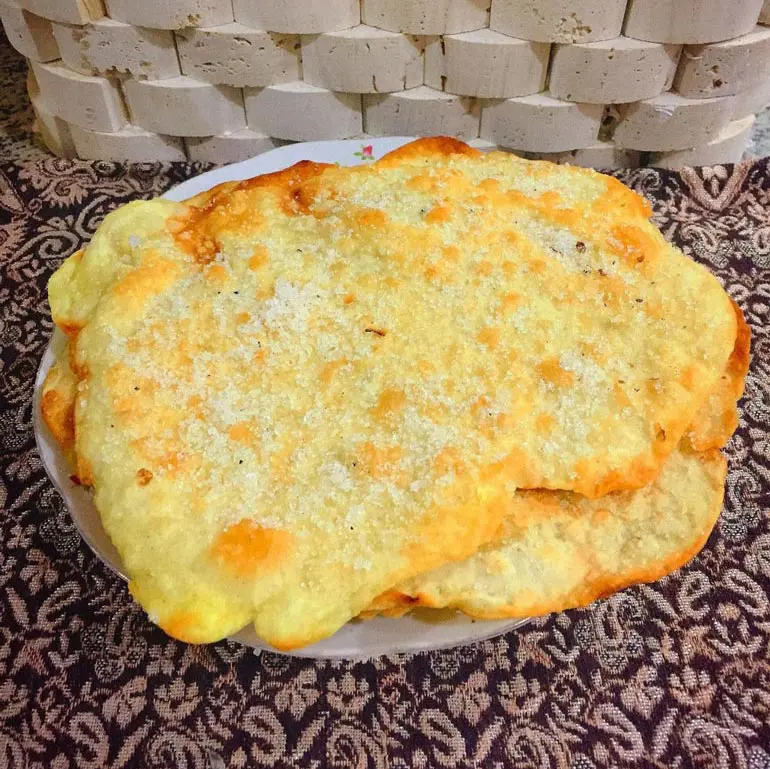
Animal ghee is a staple in all of Kermanshah’s sweets. That’s why the taste and aroma of Kermanshah’s sweets are incomparable to any other place in Iran! One of the city’s most famous sweets, made with this authentic Kermanshahi ghee, is sugar bread. Salt, sugar, wheat flour, eggs, and vanilla are the other ingredients of sugar bread. If you haven’t tried this delightful sweet during your trip to Kermanshah, be sure to do so on your next visit.
Nan Beresaq (Beresaq Bread)
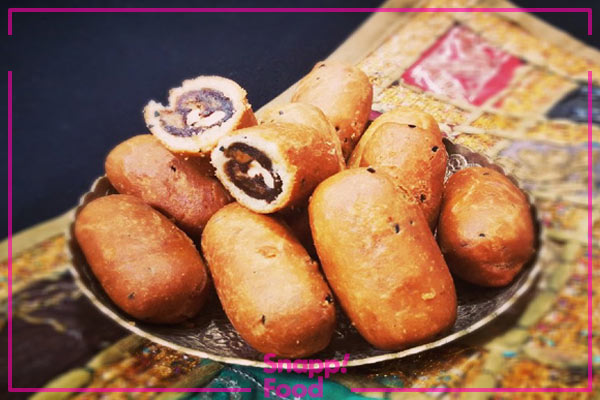
Traditional breads never lose their popularity among us food-loving Iranians. Nan Beresaq is another famous souvenir of Kermanshah, which the locals consider the best traditional bread of the region. To make this type of bread, milk, sugar, eggs, flour, salt, turmeric, and animal ghee are mixed together, and then the mixture is fried in oil. This local bread is not only delicious and nutritious but also very light and easy to digest. That’s why it holds a special place on the Iftar tables of Kermanshah’s residents.
Nan Beresaq also has a long shelf life. So, if you travel to Kermanshah, we recommend buying this traditional bread to share its delightful taste with those who couldn’t join you on your trip.
Baji Sweet
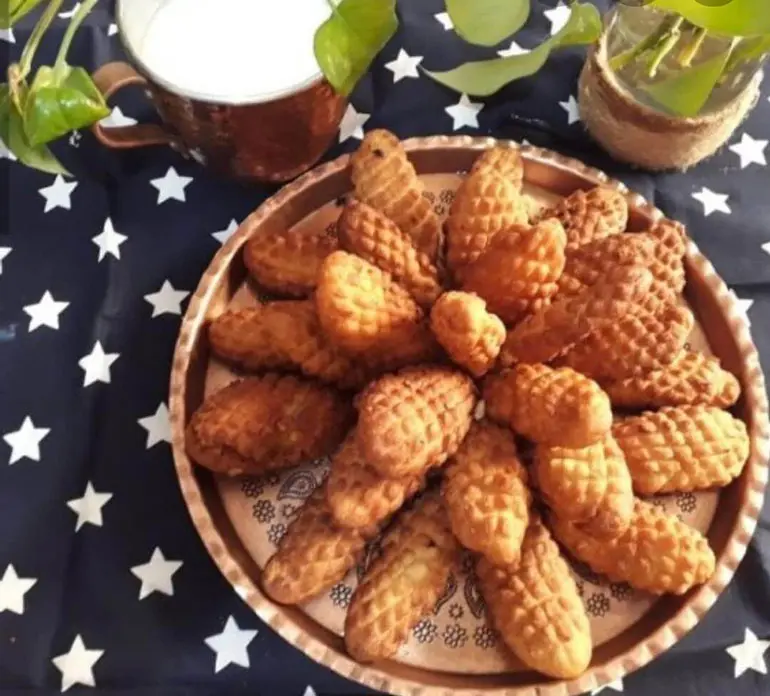
One of the lesser-known souvenirs of Kermanshah, which you may not have heard of, is Baji sweet. Despite its unknown identity, this sweet is incredibly delicious and satisfying. Just try it once, and its taste will stay with you forever. The ingredients used in making this sweet include flour, local oil, sugar, vanilla, milk, turmeric, rosewater, and fennel powder. It’s said that Baji sweet was the best provision for soldiers and travelers to relieve fatigue and hunger, which is why it was given the name “Baji,” meaning “live long” or “survive!”
Interestingly, what makes the taste of this sweet unforgettable is the aroma of fennel, which immediately captures your attention. The true people of Kermanshah enjoy this sweet for breakfast. You, too, can revolutionize your regular breakfast routine by purchasing Baji sweet.
Kermanshah Qavut
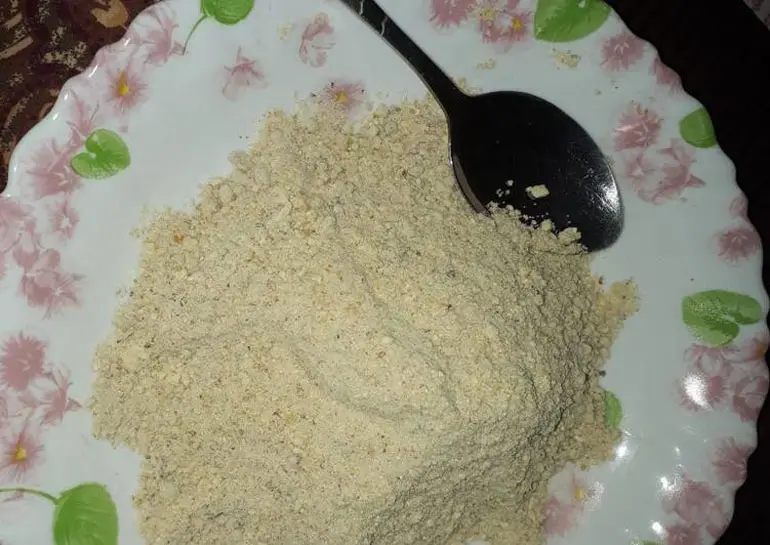
The best souvenir from Kermanshah to maintain your physical strength is Qavut. You may be familiar with the name Qavut, as Kerman also has a similar treat. This edible powder is a blend of ginger, cardamom, cloves, powdered sugar, nutmeg, flaxseed, lettuce seeds, coriander seeds, almonds, pistachios, walnuts, fennel, and chickpea flour.
Many nutritious ingredients are used in Kermanshah’s Qavut, which is why locals refer to it as the energy bomb of Kermanshah. Interestingly, Kermanshahis consider Qavut the best food for mothers after childbirth. We recommend buying some of this nutritious treat if you visit Kermanshah, so you can use its energy whenever you feel tired.
Animal Ghee
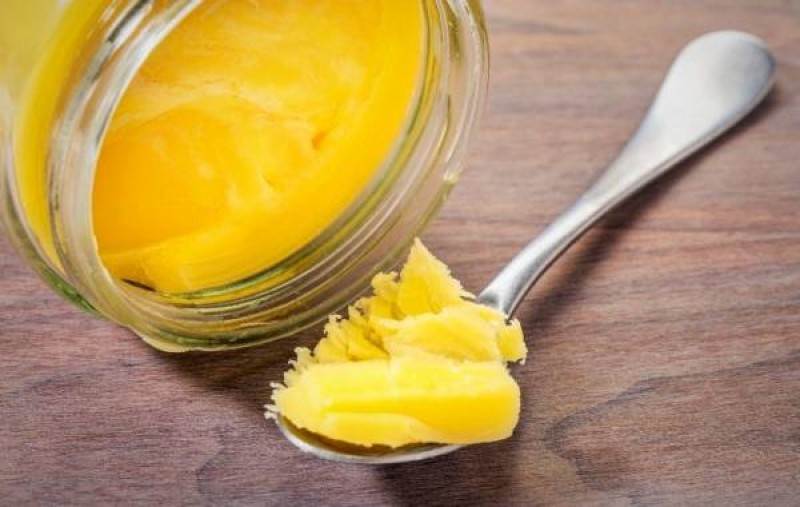
Finally, it’s time to introduce the most valuable souvenir of Kermanshah: Kermanshahi animal ghee. Known locally as “Ronan,” this ghee adds a magical flavor to dishes.
The unique taste of animal ghee is credited to Kermanshah’s excellent climate, which allows for livestock farming in lush pastures. This fragrant souvenir is made by separating the fat from cow or sheep’s milk, a skill mastered only by the local artisans of this city. In the cooking traditions of Kermanshah women, vegetable oil has no place. You can also follow this ancient tradition by purchasing Kermanshah animal ghee and adding a new flavor to your dishes.
Handicrafts of Kermanshah
As mentioned earlier, the souvenirs of Kermanshah are not limited to its colorful and delicious treats. The handicrafts of this city, which reflect the creativity and delicacy of the people of Kermanshah, form another significant part of its souvenirs. The essence of Iranian handicrafts can be seen in the artistic workshops of Kermanshah. Therefore, we recommend reserving some time during your trip to Kermanshah to explore its handicrafts. By witnessing the intricate and artistic patterns on these handmade products, you’ll gain a deeper appreciation for the city’s rich culture. Here’s a brief overview of some of Kermanshah’s traditional crafts.
Kermanshah Giveh
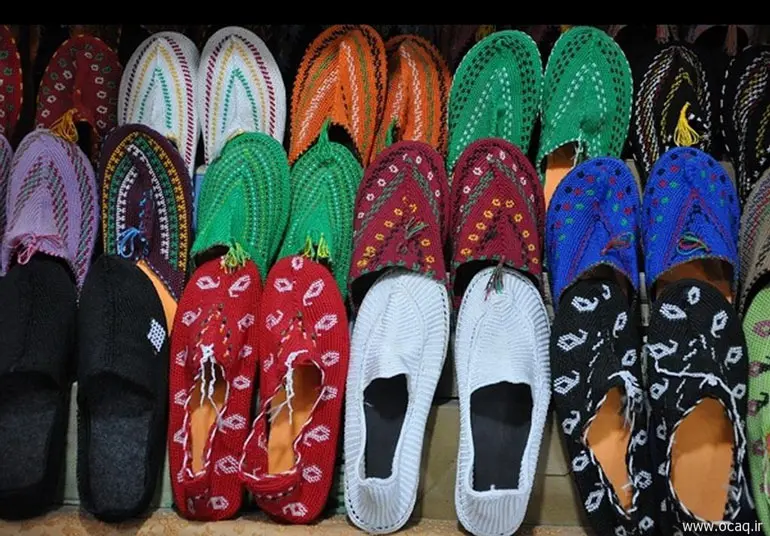
Undoubtedly, one of the most beautiful and eye-catching souvenirs from Kermanshah is the city’s traditional footwear, known as giveh. These were once common footwear but have now been largely replaced by leather shoes. There are five well-known types of giveh in Kermanshah, identified as leather-soled giveh, ajideh-soled giveh, rubber-soled giveh, fabric-soled giveh, and silk-upper giveh. The giveh consists of two parts: the sole, typically made from buffalo leather, and the upper part, woven from pure silk thread. Interestingly, while giveh weaving has been revived in many Iranian cities, the town of Nowsud in Kermanshah was the first to achieve global recognition for this craft.
Moj Weaving Products
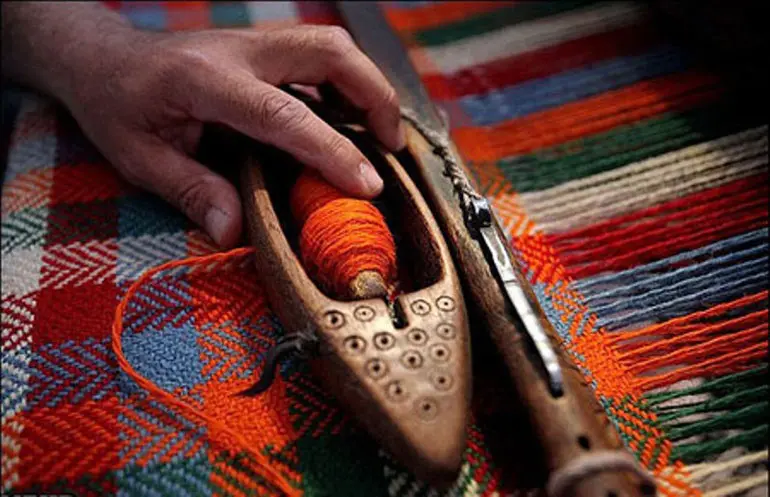
Another of Kermanshah’s notable souvenirs is the moj weaving products, known locally as rakhteh-pich. These are vibrant, geometrically patterned woolen fabrics traditionally used to wrap bedding. The colorful, rainbow-like waves in these fabrics add to their visual appeal. Some of the most distinctive patterns you might find in moj weaving include kashkouli (striped), checkered, black-and-white, four-square, barmali, and takht ghermez (red carpet).
This beautiful and traditional art has a wide range of applications. Moj weaving products can be used as prayer rugs, mats, tablecloths, curtains, bundles, and even carpets. With modern developments in the industry, products like mobile phone cases, mirror frames, and shoes are also being crafted using moj weaving techniques.
Kilims
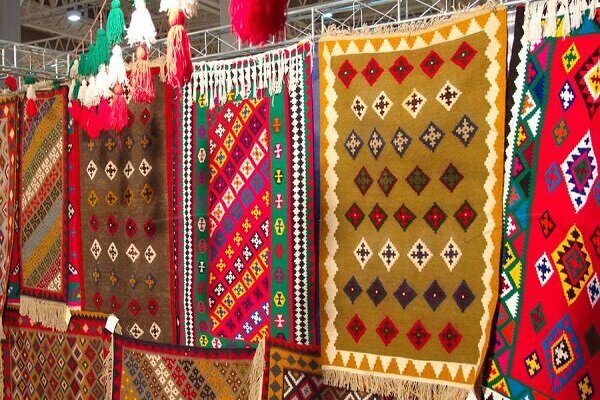
Another unique and globally recognized souvenir from Kermanshah is the kilims. The center of this art form in Kermanshah is the town of Harsin, where examples of these handwoven carpets can be found in some of the world’s best museums. This craft is also practiced in other towns like Gilan-e Gharb, Rijab, and Javanrud, but it is the Harsin kilims that have brought international fame to Kermanshah.
The Kermanshah kilim is a product of the skilled hands of the women in this region. Notable patterns in kilim weaving include designs of trees and sparrow nests, snakes, ducks, dolls, vertical and horizontal lines, sawtooth stripes, cat’s paw, scissor shapes, gharch-e-kharbozeh (melon slice), gol mashrafi (Mashrafi flower), paisley, and needle motifs.
Felt Products

Felt products are another traditional souvenir of Kermanshah, representing one of the oldest crafts in the region. The best examples of felt products can often be found among the nomadic tribes, where they are used as rugs in their black tents or worn by shepherds. The felt made in Kermanshah is usually produced in black and white, although other colors like red, green, orange, and purple are sometimes used for decoration.
Arghavan Weaving Products
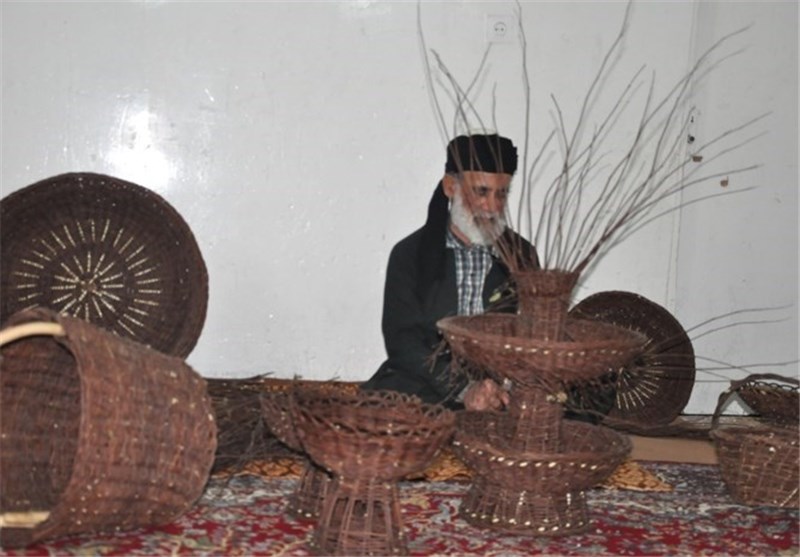
Arghavan weaving products, also known as basketry, are another type of souvenir from Kermanshah. The craft of basket weaving using thin tree branches is an ancient art in Iran, with a history as old as humanity itself! Since the artisans of Kermanshah use strong and sturdy branches from the arghavan tree, this craft is referred to as arghavan weaving. The best place to witness the skills of women in basket weaving is the village of Darian in the county of Paveh.
If you need a guide for exploring the attractions of Kermanshah, be sure to read the article titled “Exploring the Attractions of Kermanshah in Gulf City Pedia magazine.
Metal Engraving Products
Metal engraving is another captivating art form from Kermanshah, inspired by the tumultuous eras of the Achaemenid and Sassanian periods. Master Ali Akbar Einolghozai is a renowned metal engraver from Kermanshah, whose teachings have kept this art and its products alive and thriving in the city.
Jajim of Kermanshah
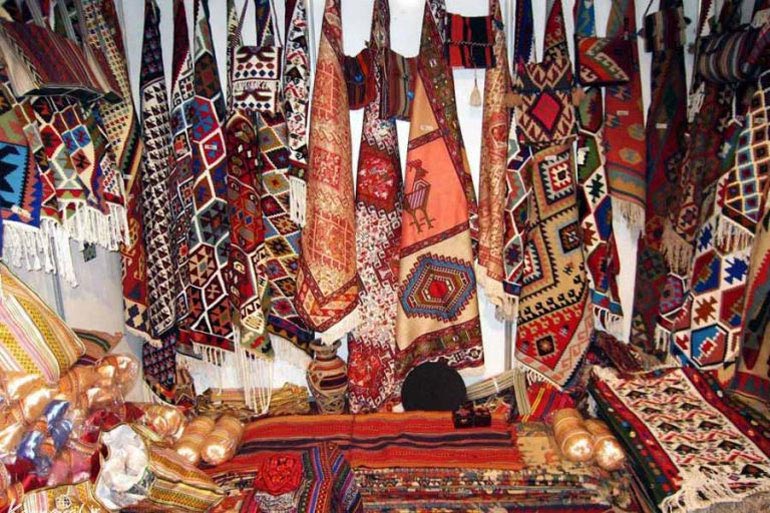
Jajim is a member of the kilim family, made from sheep’s wool, similar to kilim weaving. However, unlike kilims, which are used as rugs, Jajims are warm covers. Another difference between kilims and Jajims is the weaving technique. Jajims are typically woven on a four-board loom, and once the four corners are connected, they create a warm blanket. The best place to find high-quality Jajims is in the Oramanat and Salas Babajani regions.
Chiq Weaving Products of Kermanshah

One of the most unique and indigenous souvenirs of Kermanshah, which you won’t find anywhere else in Iran, is Chiq weaving products. Chiqs are decorated mats with colorful patterns used to protect black tents. The two main materials used in Chiq weaving are reeds and thread, and weaving them together requires great patience and skill.
Carpets and Rugs of Kermanshah

Undoubtedly, carpet weaving is one of the traditional Iranian arts that still holds a special place in our culture. Although this art is widespread across the country, each city and village has its unique principles and styles, often influenced by the region’s climate and culture. The art of carpet weaving in Kermanshah adheres strictly to these traditions. As a result, the patterns on Kermanshah carpets vividly reflect the customs and traditions of the city’s people.
Some of the popular local patterns in Kermanshah carpet weaving include Moini, Samavari, Dargol, Abdollahi, Kiyonani, Akbarabadi, and Hosseini Abadi. Among these, the most famous and cherished design is the Bazubandi pattern, considered the hallmark of Kermanshah carpets. Today, villages like Songhor, Dinavar, Bisotun, Kangavar, and Sahneh are known for keeping this traditional art alive.
Leather of Kermanshah

You might have heard about the famous leather of Kermanshah. Leathercraft is a traditional and beautiful art in this city, and the skilled artisans of Kermanshah go through a lengthy and intricate process to produce it. The process includes soaking the hides, applying lime, scraping, swelling, salting, tanning, glazing, dyeing, and polishing, just to name a few steps. If you visit Kermanshah, make sure to explore the leather products of this city.
Musical Instruments
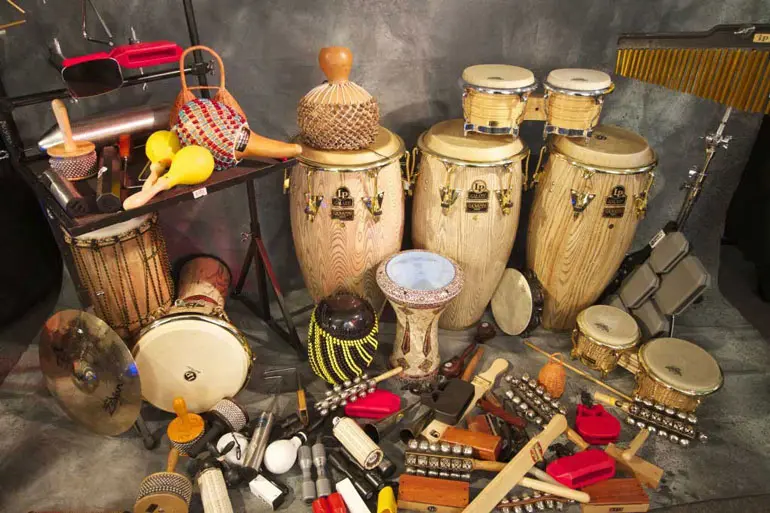
If you have a passion for music, purchasing some of the best souvenirs from Kermanshah, such as musical instruments, will offer you a new and exciting experience in playing music. Daf and Tanbur (locally known as Tambureh) are among the most common instruments in Kermanshah. Other instruments made in the city include Chogur, Divan, and Setar, each with subtle differences from the Tanbur.
Where to Buy Kermanshah Souvenirs ?
Now that you are familiar with the various types of souvenirs from Kermanshah, it’s time to learn about the best places to buy them. Souvenirs from Kermanshah can be found all over the city. However, if you’re looking for the finest and most authentic souvenirs, you’ll need to visit the main shopping centers. Stay with us as we introduce the most famous places to buy souvenirs in Kermanshah.
Friday Market in Kermanshah
One of the best places to buy handicrafts in Kermanshah is the Friday Market, which takes place every Friday in the Eastern Park of Kermanshah. Interestingly, this market itself is listed as a tourist attraction in Kermanshah. So, it serves as both a shopping spot and a tourist destination!
Address: Kermanshah, Eastern Park, near the Taq-e Bostan mountain.
Elahiyeh Shopping Center
If you have a short stay in Kermanshah and don’t have time to visit multiple shops, head to the Elahiyeh Shopping Center. This mall offers everything you could think of, allowing you to buy all your desired souvenirs in one place and in the least amount of time.
Address: Kermanshah, Elahiyeh Town, Kashani Street.
Traditional Market or Tarekeh Bazaar
Another important and historic place to shop for souvenirs in Kermanshah is the Traditional Market, also known as Tarekeh Bazaar. This market, a remnant from the Qajar era during the reign of Fath Ali Shah, holds a significant portion of Kermanshah’s visual attractions. Its notable features include an organized and cohesive structure, as well as arcades, shops, teahouses, caravanserais, Tekiyehs, and mosques.
Address: Kermanshah, Enqelab Square, Modarres Street.
Rice Flour Bread Market in Kermanshah
It’s almost impossible to visit Kermanshah and skip buying from the Rice Flour Bread Market. This market is the main center for traditional sweets in the city. When you step into this market, the delightful aroma of cardamom, rosewater, and animal oil will greet you.
The market is a combination of several small pastry workshops that offer freshly made sweets. Located near some of the city’s top attractions, you can enjoy fresh and hot Kermanshah souvenirs while also exploring the city’s tourist sites.
Address: Kermanshah, Motahari Boulevard, Modarres Street.
Kermanshah SouvenirsA Vibrant Blend of Color, Pattern, and Flavor When Kermanshah is mentioned, it often conjures images of the grand ancient monuments of the city. Indeed, Kermanshah is one of the most beautiful cities in western Iran. Its souvenirs are as remarkable as its historical sites. A visit to the workshops of Kermanshah’s talented artists will reveal the beauty and grandeur of the city’s rich culture and heritage. This article has provided a comprehensive guide to the best souvenirs Kermanshah has to offer. Whether you are booking a plane ticket or a train ticket to visit this city, don’t miss out on experiencing its souvenirs!
Now it’s your turn to share your experiences of traveling to this city in the comments section and become a guide for our readers on Gulf City Pedia.
Frequently Asked Questions about Kermanshah Souvenirs
What are the souvenirs of Kermanshah? Souvenirs include food items and handicrafts. Some of the best food items are Rice Flour Bread, Date Bread, and Animal Oil, while notable handicrafts include Kilims, Jajims, Chiqs, and Wave Weaving products.
Where is the best place to buy fresh Kermanshah sweets? The Rice Flour Bread Market in Kermanshah is the best place to buy fresh and high-quality sweets.
Where can I buy genuine animal oil from Kermanshah? Famous stores for purchasing animal oil in Kermanshah include Bistoon, Shekarez, and Nowruz.
What are the popular sweets and desserts of Kermanshah? Popular sweets and desserts include Rice Flour Bread, Kak Sweets, Date Bread, Sugar Bread, Borsagh Bread, and Baji Sweets.



